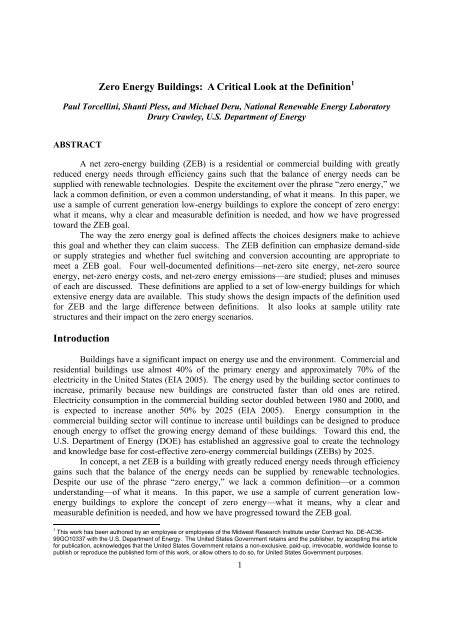Session 1 - Montefiore
Session 1 - Montefiore
Session 1 - Montefiore
Create successful ePaper yourself
Turn your PDF publications into a flip-book with our unique Google optimized e-Paper software.
Zero Energy Buildings: A Critical Look at the Definition 1<br />
Paul Torcellini, Shanti Pless, and Michael Deru, National Renewable Energy Laboratory<br />
Drury Crawley, U.S. Department of Energy<br />
ABSTRACT<br />
A net zero-energy building (ZEB) is a residential or commercial building with greatly<br />
reduced energy needs through efficiency gains such that the balance of energy needs can be<br />
supplied with renewable technologies. Despite the excitement over the phrase “zero energy,” we<br />
lack a common definition, or even a common understanding, of what it means. In this paper, we<br />
use a sample of current generation low-energy buildings to explore the concept of zero energy:<br />
what it means, why a clear and measurable definition is needed, and how we have progressed<br />
toward the ZEB goal.<br />
The way the zero energy goal is defined affects the choices designers make to achieve<br />
this goal and whether they can claim success. The ZEB definition can emphasize demand-side<br />
or supply strategies and whether fuel switching and conversion accounting are appropriate to<br />
meet a ZEB goal. Four well-documented definitions—net-zero site energy, net-zero source<br />
energy, net-zero energy costs, and net-zero energy emissions—are studied; pluses and minuses<br />
of each are discussed. These definitions are applied to a set of low-energy buildings for which<br />
extensive energy data are available. This study shows the design impacts of the definition used<br />
for ZEB and the large difference between definitions. It also looks at sample utility rate<br />
structures and their impact on the zero energy scenarios.<br />
Introduction<br />
Buildings have a significant impact on energy use and the environment. Commercial and<br />
residential buildings use almost 40% of the primary energy and approximately 70% of the<br />
electricity in the United States (EIA 2005). The energy used by the building sector continues to<br />
increase, primarily because new buildings are constructed faster than old ones are retired.<br />
Electricity consumption in the commercial building sector doubled between 1980 and 2000, and<br />
is expected to increase another 50% by 2025 (EIA 2005). Energy consumption in the<br />
commercial building sector will continue to increase until buildings can be designed to produce<br />
enough energy to offset the growing energy demand of these buildings. Toward this end, the<br />
U.S. Department of Energy (DOE) has established an aggressive goal to create the technology<br />
and knowledge base for cost-effective zero-energy commercial buildings (ZEBs) by 2025.<br />
In concept, a net ZEB is a building with greatly reduced energy needs through efficiency<br />
gains such that the balance of the energy needs can be supplied by renewable technologies.<br />
Despite our use of the phrase “zero energy,” we lack a common definition—or a common<br />
understanding—of what it means. In this paper, we use a sample of current generation lowenergy<br />
buildings to explore the concept of zero energy—what it means, why a clear and<br />
measurable definition is needed, and how we have progressed toward the ZEB goal.<br />
1 This work has been authored by an employee or employees of the Midwest Research Institute under Contract No. DE-AC36-<br />
99GO10337 with the U.S. Department of Energy. The United States Government retains and the publisher, by accepting the article<br />
for publication, acknowledges that the United States Government retains a non-exclusive, paid-up, irrevocable, worldwide license to<br />
publish or reproduce the published form of this work, or allow others to do so, for United States Government purposes.<br />
1











